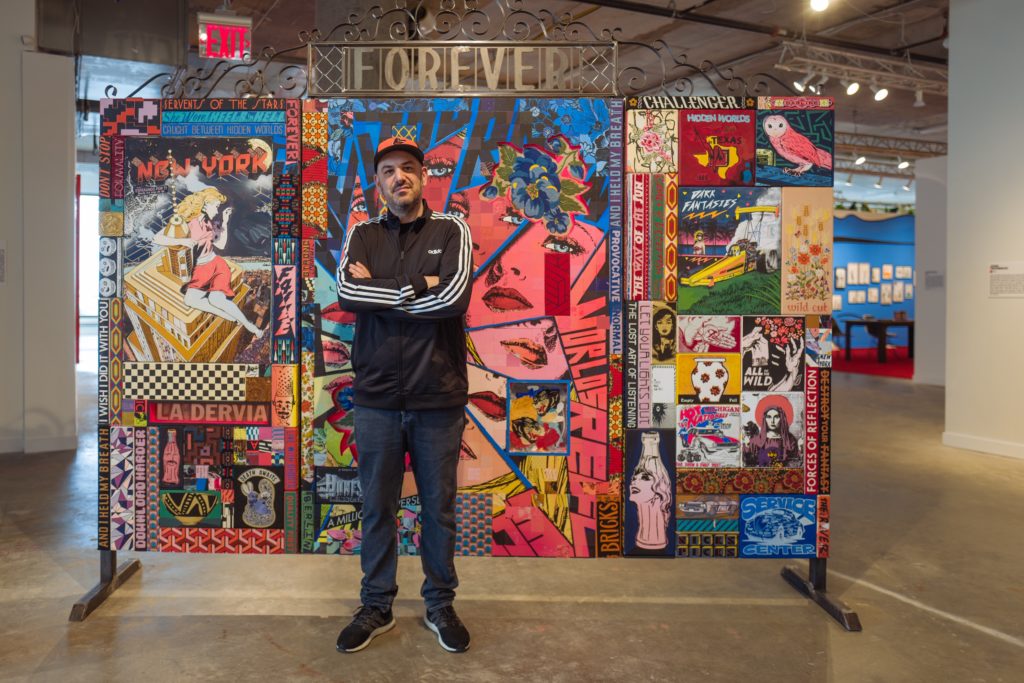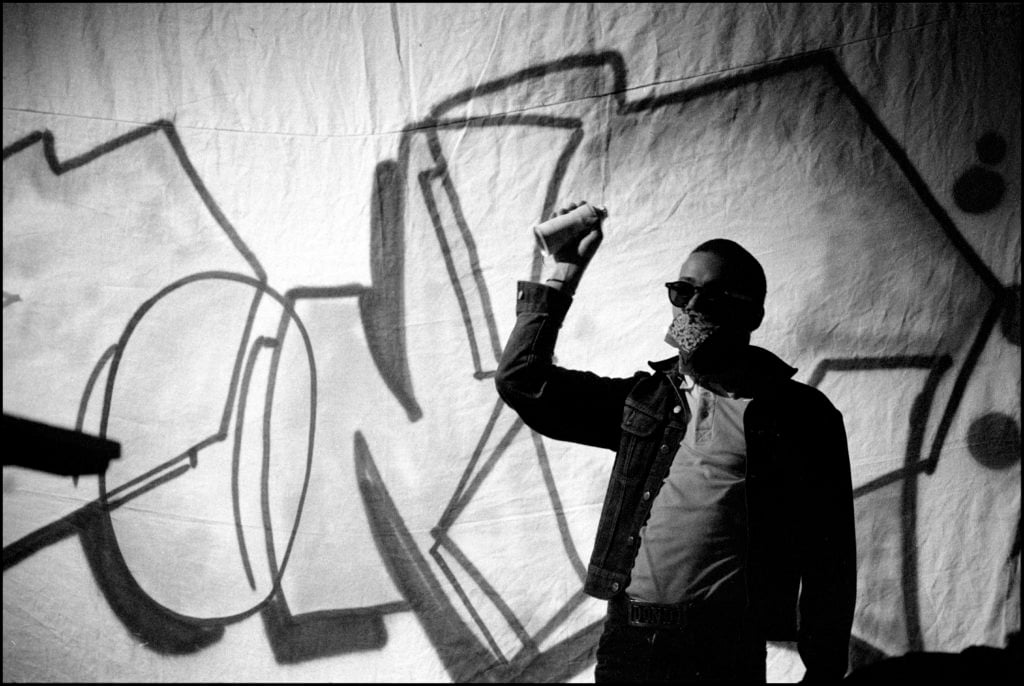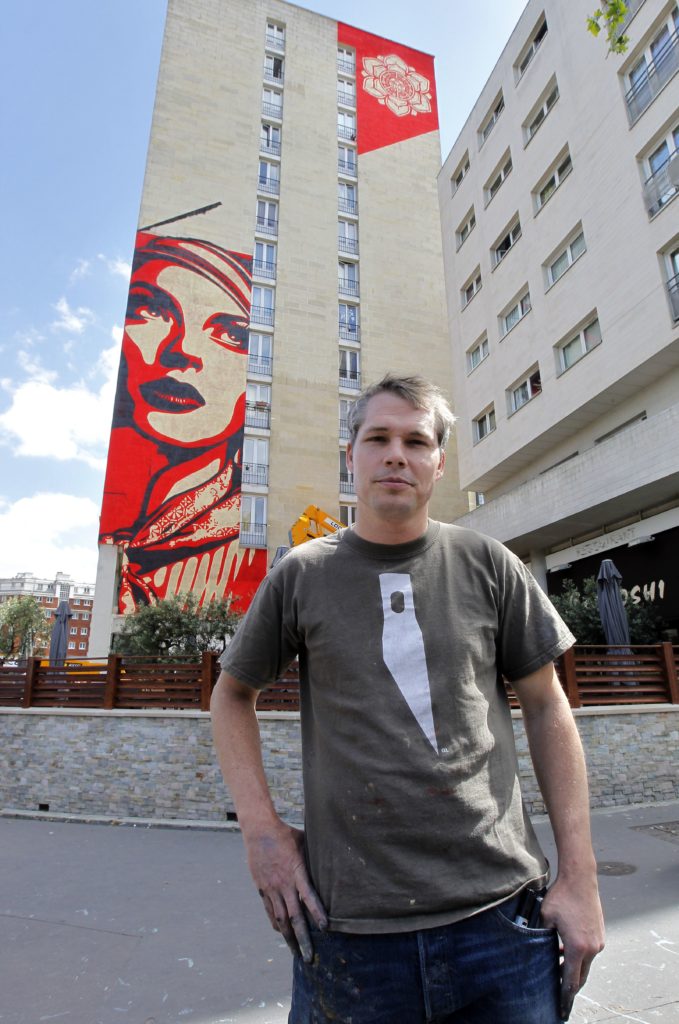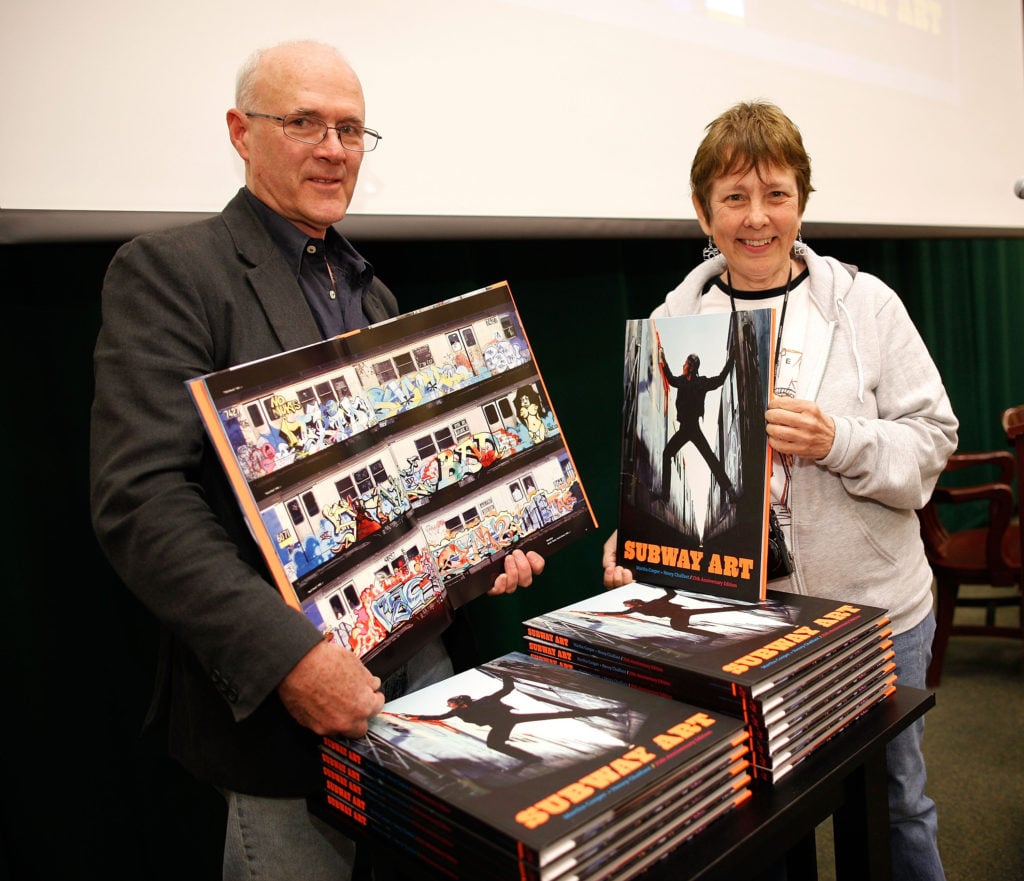People
‘This Culture Has Ballooned Into a Phenomenon’: Street Art Expert Roger Gastman on How the Outlaw Medium Became Big Business
Gastman's latest show on the history and evolution of street art, "Beyond the Streets," has just opened in Brooklyn.

Gastman's latest show on the history and evolution of street art, "Beyond the Streets," has just opened in Brooklyn.

Pac Pobric

It all started with a skinny Greek kid from upper Manhattan named Dimitrios. In the 1960s, he was a delivery boy making the rounds of New York City on the subway. And because he was a little bored and figured it might be fun, he started scrawling his nickname in crude bold letters inside subway cars and on street signs, followed by the street he lived on. Before long, TAKI 183 gained the attention of the New York Times for the mess he was making across the city.
From there, graffiti blossomed, and within 15 years of TAKI 183’s mention in the paper, figures like SKEME, DONDI, and LEE were spending late nights in Queens train yards elaborately painting subway cars: burners, they called them, because the pieces were as impossible to ignore as a five-alarm fire.
The goal was to be seen. And even though, 50 years later, subway art is no more (you can blame former New York mayor Ed Koch for that), graffiti and street artists still want fame—and historian and curator Roger Gastman wants to help them get it.
In 2011, he co-organized (with Jeffrey Deitch) the landmark exhibition “Art in the Streets” at the Museum of Contemporary Art, Los Angeles, a proper survey of graffiti and street art charting its rise and many permutations. Gastman is back at it now with a sprawling New York follow-up, “Beyond the Streets,” which looks at street artists who have developed rigorous studio practices. The enormous show—developed in partnership with adidas and Perrier and held in the retail and commercial Brooklyn building 25 Kent, a far cry from the form’s anti-establishment origins—includes more than 150 artists. Many of them, including FAILE and Paul INSECT, have made works specially for the exhibition. There are also some big names like Takashi Murakami, but the real appeal of the show, for anyone interested in the history, will be works by New York City graffiti legends like Lady Pink, BLADE, and Futura 2000.
We spoke with Gastman about the show and the evolution of street-art culture.

American grafitti artist DONDI in November 1982. Photo by David Corio/Redferns.
Help me situate “Beyond the Streets” in the context of “Art in the Streets” at MOCA in Los Angeles. That earlier show was a global history of graffiti, from New York to London to São Paulo and beyond. What made this follow-up exhibition necessary, and what makes it distinct?
“Art in the Streets” was an awesome show, and it really showed a lot of incredible historical pieces, with great timelines and a good overview of how large the culture had become, and it looked at a lot of its roots. Since then, so much has changed. The culture has just continued to grow so much, and there is not a ton of historical information out there that puts things in context. And in any large survey, there are a ton of people you would love to include, but you only have so much room and you can only tell so many stories each time.
Our show here in New York has a lot of the same work and a lot of the same artists, but we’ve expanded the mission, the list of artists, and a majority of them have made new work for us.
In terms of growth, has a certain part of the culture become especially popular?
Murals have become more and more popular around the world and there are mural festivals from every bad neighborhood to every fancy neighborhood. I’m happy that there is so much more public art everywhere. And often murals are inspired by graffiti artists and the tools and techniques of graffiti. But, you know, a true street artist has spent years and years illegally working on the street. You go do 50 murals, you’re a muralist; you’re not a street artist. Many of these murals and festivals are happening because of gentrification: developers look at them as good ways to clean up the neighborhood.
I don’t want to sound negative towards these mural festivals or muralists at all. I love seeing it and I love that they’re drawing inspiration from this culture. But I wanted to put together a show that was really about artists that have done a lot of work on the streets, who really fit the definition of rule-breaker and mark-maker.
I’m sure there is probably also a lot of internal discussion within the culture about what it means to have a show like this, or to be institutionalized by MOCA. I am sure there are some people who are just graffiti artists in New York who may just not be as open. Would someone like JA One or KEZ 5 be interested in this show?
Something important to note is that we worked directly with all of the artists we could. The people that are in the show, if they’re living, are in this show because they want to be, and they worked with us to be in it. This show is not reclaimed street art or graffiti from the street. This show is of studio works.
And of course, not everyone wants their work shown in this context, and we respect that and do the best we can. And some artists don’t necessarily fit the criteria of the show, because it’s mostly about people that went on to have highly disciplined studio practices.

Shepard Fairey poses in front his work in Paris. Photo: Pierre Verdy/AFP/Getty Images.
What is it about this culture that makes it so flexible that it can accommodate studio practices and so much more? The history starts off—this is the story we usually hear—with TAKI 183, a Greek kid from upper Manhattan running around in the 1960s and ‘70s just writing his name everywhere he can. And it evolves, 50 years later, into someone like Shepard Fairey, who’s making enormous murals. Why is this art form so able to accommodate so many different styles?
It’s just growth, you know? You start small, you start simple. And with graffiti, someone adds an arrow. Someone adds a star. Someone underlines something and you just keep going and going. Someone figures out how to cut a stencil. Someone figures out how to cut a stencil with two colors. Someone figures out, “hey, that wallpaper paste that I saw people using in their apartment—I could use that to put up a poster.” It just keeps growing like that.
And I imagine that growth had to do with the fact that this is something you can do yourself without a tremendous amount of support.
Absolutely. You can do it yourself. You can do it on your own terms. You can do it 24 hours a day, in a sense. You can be your own boss.
Let’s talk about studio practice. What kinds of conditions were in place that made it possible for these artists to move from the streets to the studio? Was it a generational shift?
I think people just start to grow up. You know, everyone has a different story, so it’s hard to speak for the entire culture. But overall, with the early writers of the late 1960s to mid-’70s, it was so common that by the time they graduated high school, they got jobs, joined the service, etc., and graffiti was phased out. It was done. People had kids, got married. But as subway art in New York got more and more popular in the late ’70s and early ’80s, the press—especially in Europe—was starting to pay attention, and artists started painting canvases.
But overall, why do people do [studio work]? I think it’s just that they’ve done a lot on the streets. And it’s not like there’s nothing else they can do out there, but they’ve worked on the streets and it’s time to expand.

Henry Chalfant and Martha Cooper sign copies of the 25th Anniversary Edition of Subway Art. Photo by Jemal Countess/WireImage.
I know photography plays a big role here, because part of the rise of this culture is attributable to the fact that it spreads very efficiently through the photographs of people like Henry Chalfant and Martha Cooper.
Absolutely. The book Subway Art [by Henry Chalfant and Martha Cooper], followed by Spraycan Art [by Henry Chalfant and James Prigoff] a few years later, is so important to the culture. You can talk to so many people, from Los Angeles to Berlin, who stole Subway Art from their school libraries and learned to do this or copy that from the book. It also made New York City the legendary place they wanted to go. Without the wonderful photography of Henry and Martha, the culture would not have been what it is. And then of course, the films Style Wars and Wild Style—love them or hate them—spread the culture even further.
Early on though, little known to many people, [photographer] Jon Naar in the early ’70s documented a lot of the wall writing, more of the TAKI-era things. And he made an incredible book, Faith of Graffiti, that a lot of people don’t know about. Norman Mailer wrote the essays for that.
Then there’s Gordon Matta-Clark, of course, with the photos of graffiti he shot in ’73, which we have a lot of in the show. He shot 2,000 photos, give or take, of graffiti that summer, so there were true artists and true photographers out there documenting this history early on. Not as many as I wish there were, because the documentation is so important and hard to come by. But usually the kids that were writing it themselves were not really documenting it.
So what do you want people to take away from “Beyond the Streets”? What’s the bottom line?
You know, this culture—which was started by youths writing their names over and over again for the sake of fame and fun and notoriety—has ballooned into a worldwide cultural phenomenon. So many of the pioneers are still with us today. A lot of them are getting older. But let’s learn from them. Let’s respect them. And let’s preserve the history as much as we can while they’re with us, before it’s too late.
“Beyond the Streets” is on view from June 21 through August at 25 Kent Avenue, Brooklyn, New York. General admission is $25.